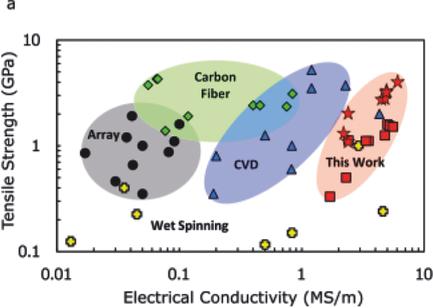当前位置:
X-MOL 学术
›
Adv. Mater.
›
论文详情
Our official English website, www.x-mol.net, welcomes your
feedback! (Note: you will need to create a separate account there.)
Structure–Property Relations in Carbon Nanotube Fibers by Downscaling Solution Processing
Advanced Materials ( IF 27.4 ) Pub Date : 2018-01-11 , DOI: 10.1002/adma.201704482 Robert J. Headrick 1 , Dmitri E. Tsentalovich 1 , Julián Berdegué 1 , Elie Amram Bengio 1 , Lucy Liberman 2 , Olga Kleinerman 2 , Matthew S. Lucas 3, 4 , Yeshayahu Talmon 2 , Matteo Pasquali 1
Advanced Materials ( IF 27.4 ) Pub Date : 2018-01-11 , DOI: 10.1002/adma.201704482 Robert J. Headrick 1 , Dmitri E. Tsentalovich 1 , Julián Berdegué 1 , Elie Amram Bengio 1 , Lucy Liberman 2 , Olga Kleinerman 2 , Matthew S. Lucas 3, 4 , Yeshayahu Talmon 2 , Matteo Pasquali 1
Affiliation

|
At the microscopic scale, carbon nanotubes (CNTs) combine impressive tensile strength and electrical conductivity; however, their macroscopic counterparts have not met expectations. The reasons are variously attributed to inherent CNT sample properties (diameter and helicity polydispersity, high defect density, insufficient length) and manufacturing shortcomings (inadequate ordering and packing), which can lead to poor transmission of stress and current. To efficiently investigate the disparity between microscopic and macroscopic properties, a new method is introduced for processing microgram quantities of CNTs into highly oriented and well‐packed fibers. CNTs are dissolved into chlorosulfonic acid and processed into aligned films; each film can be peeled and twisted into multiple discrete fibers. Fibers fabricated by this method and solution‐spinning are directly compared to determine the impact of alignment, twist, packing density, and length. Surprisingly, these discrete fibers can be twice as strong as their solution‐spun counterparts despite a lower degree of alignment. Strength appears to be more sensitive to internal twist and packing density, while fiber conductivity is essentially equivalent among the two sets of samples. Importantly, this rapid fiber manufacturing method uses three orders of magnitude less material than solution spinning, expanding the experimental parameter space and enabling the exploration of unique CNT sources.
中文翻译:

碳纳米管纤维的降尺度溶液处理结构与性能的关系
在微观尺度上,碳纳米管(CNT)结合了令人印象深刻的拉伸强度和导电性。但是,他们的宏观同行没有达到预期。原因多种多样地归因于固有的CNT样品特性(直径和螺旋多分散性,缺陷密度高,长度不足)和制造缺陷(订购和填充不足),这可能导致应力和电流的传递不良。为了有效地研究微观和宏观特性之间的差异,引入了一种新方法,用于将微克数量的CNT处理为高度定向和堆积良好的纤维。碳纳米管溶解在氯磺酸中并加工成取向膜。可以将每张薄膜剥皮并捻成多根离散的纤维。直接比较用这种方法和固溶纺丝制成的纤维,以确定排列,扭曲,堆积密度和长度的影响。出乎意料的是,尽管排列程度较低,但这些离散光纤的强度却是其固溶纺丝光纤的两倍。强度似乎对内部扭曲和堆积密度更敏感,而两组样品中的纤维电导率基本上相等。重要的是,这种快速的纤维制造方法比溶液纺丝使用的材料少三个数量级,从而扩大了实验参数空间,并能够探索独特的CNT来源。尽管排列程度较低,但这些离散光纤的强度是其固溶纺丝光纤的两倍。强度似乎对内部扭曲和堆积密度更敏感,而两组样品中的纤维电导率基本上相等。重要的是,这种快速的纤维制造方法比溶液纺丝使用的材料少三个数量级,从而扩大了实验参数空间,并能够探索独特的CNT来源。尽管排列程度较低,但这些离散光纤的强度是其固溶纺丝光纤的两倍。强度似乎对内部扭曲和堆积密度更敏感,而两组样品中的纤维电导率基本上相等。重要的是,这种快速的纤维制造方法比溶液纺丝使用的材料少三个数量级,从而扩大了实验参数空间,并能够探索独特的CNT来源。
更新日期:2018-01-11
中文翻译:

碳纳米管纤维的降尺度溶液处理结构与性能的关系
在微观尺度上,碳纳米管(CNT)结合了令人印象深刻的拉伸强度和导电性。但是,他们的宏观同行没有达到预期。原因多种多样地归因于固有的CNT样品特性(直径和螺旋多分散性,缺陷密度高,长度不足)和制造缺陷(订购和填充不足),这可能导致应力和电流的传递不良。为了有效地研究微观和宏观特性之间的差异,引入了一种新方法,用于将微克数量的CNT处理为高度定向和堆积良好的纤维。碳纳米管溶解在氯磺酸中并加工成取向膜。可以将每张薄膜剥皮并捻成多根离散的纤维。直接比较用这种方法和固溶纺丝制成的纤维,以确定排列,扭曲,堆积密度和长度的影响。出乎意料的是,尽管排列程度较低,但这些离散光纤的强度却是其固溶纺丝光纤的两倍。强度似乎对内部扭曲和堆积密度更敏感,而两组样品中的纤维电导率基本上相等。重要的是,这种快速的纤维制造方法比溶液纺丝使用的材料少三个数量级,从而扩大了实验参数空间,并能够探索独特的CNT来源。尽管排列程度较低,但这些离散光纤的强度是其固溶纺丝光纤的两倍。强度似乎对内部扭曲和堆积密度更敏感,而两组样品中的纤维电导率基本上相等。重要的是,这种快速的纤维制造方法比溶液纺丝使用的材料少三个数量级,从而扩大了实验参数空间,并能够探索独特的CNT来源。尽管排列程度较低,但这些离散光纤的强度是其固溶纺丝光纤的两倍。强度似乎对内部扭曲和堆积密度更敏感,而两组样品中的纤维电导率基本上相等。重要的是,这种快速的纤维制造方法比溶液纺丝使用的材料少三个数量级,从而扩大了实验参数空间,并能够探索独特的CNT来源。










































 京公网安备 11010802027423号
京公网安备 11010802027423号